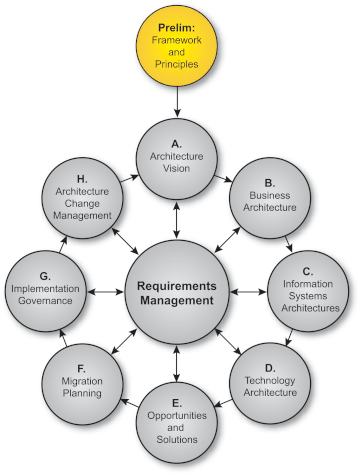
| You are here: | ||
| <<< Previous | Home | Next >>> |
This chapter describes the architecture framework and the definition of principles.

The objectives of the Preliminary Phase are:
This Preliminary Phase is about defining "how we do architecture" in the enterprise concerned. There are two main aspects: defining the framework to be used; and defining the architecture principles that will inform any architecture work.
The enterprise's approach to re-use of architecture assets is a key part of both the framework definition and architecture principles. (Typically the principles will state the policy on re-use; and the framework will explain how re-use is effected.)
In federated architectures (see Enterprise Scope/Focus), requirements from a higher-level architecture are often manifested as "principles" in lower-level architectures.
The Preliminary Phase defines the architecture principles that will form part of the constraints on any architecture work undertaken in the enterprise. The issues involved in this are explained in Part IV: Resource Base, Architecture Principles .
Architecture work is informed by business principles as well as architecture principles. The architecture principles themselves are also normally based in part on business principles. Defining business principles normally lies outside the scope of the architecture function. However, depending on how such principles are defined and promulgated within the enterprise concerned, it may be possible for the set of architecture principles to also restate, or cross-refer to a set of business principles, business goals, and strategic business drivers defined elsewhere within the enterprise. (Within an architecture project, the architect will normally need to ensure that the definitions of these business principles, goals, and strategic drivers are current, and to clarify any areas of ambiguity.)
The issue of architecture governance is closely linked to that of architecture principles. The body responsible for governance will also normally be responsible for approving the architecture principles, and for resolving architecture issues. This will normally be one of the principles cited. The issues involved in governance are explained in Part IV: Resource Base, Architecture Governance .
The TOGAF Architecture Development Method (ADM) is a generic method, intended to be used by enterprises in a wide variety of industry types and geographies. It is also designed for use with a wide variety of other enterprise architecture frameworks, if required (although it can be used perfectly well in its own right, without adaptation).
The Preliminary Phase therefore involves doing any necessary work to adapt the ADM to define an organization-specific framework, using either the TOGAF deliverables or the deliverables of another framework. The issues involved in this are discussed in Adapting the ADM .
The inputs to the Preliminary Phase are:
The TOGAF ADM is a generic method, intended to be used by a wide variety of different enterprises, and in conjunction with a wide variety of other architecture frameworks, if required. It is not practical to define specific steps for adapting the ADM to such a wide variety of potential contexts. The issues involved are discussed in detail in Adapting the ADM .
The outputs of the Preliminary Phase are:
The TOGAF document set is designed for use with frames. To navigate around the document:
Downloads of the TOGAF documentation, are available under license from the TOGAF information web site. The license is free to any organization wishing to use TOGAF entirely for internal purposes (for example, to develop an information system architecture for use within that organization). A hardcopy book is also available from The Open Group Bookstore as document G063.